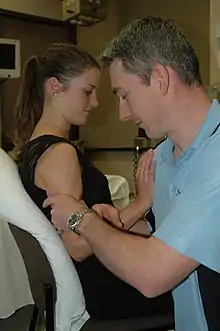

Cunningham shoulder reduction was originally published in 2003 [1] and is an anatomically based method of shoulder reduction that utilizes positioning (analgesic position), voluntary scapular retraction, and bicipital massage. It is designed for true anterior/subcoracoid glenohumeral dislocations in patients who can fully adduct their humerus.[2] This is distinct from anteroinferior/subglenoid glenohumeral dislocations for which alternative techniques should be used.[3] The method is one of several techniques used for shoulder reduction.[4][5][6]
Mechanism
Shoulder dislocation is a common complication of upper limb trauma (arm pulled while in abduction or direct impact to shoulder) resulting with the humeral head sitting anteriorly out of the glenoid fossa.
Technique is as follows:[2]
Step 1 Sit patient up (without slouching, towel or pillow down spine) and place into analgesic position. ‘Hold’- take control of the affected limb with a 'hold.' This is a firm steady downward hold (not a pull) designed to move the humeral head towards where it needs to be, taking off some of the stretch from the capsule (reducing pain), and providing confidence to the patient that you have taken control of the limb. Once you are in this position, it can be useful to ask the patient their pain level, and explain again what you are going to do. It’s important to note that the elbow is not being supported from below, but is being placed in a downwards ‘hold’. The affected arm is adducted (next to the body) and the elbow fully flexed (optimally shortens the biceps muscle, allowing full relaxation) The humerus points directly down and should be in a neutral position (no forward flexion or external rotation). Ask the patient to “shoulders back, chest out.” (reducing scapular anteversion and so reducing the static obstruction of the glenoid rim). Kneel next to your patient and place your wrist onto their forearm, with their hand resting on your shoulder.
Step 2 Massage the biceps. Ask your patient to again put “shoulders back, chest out” and relax. Massage the biceps (gently) at mid humeral level. Wait for your patient to fully relax and the humeral head slips back into place. Tell your patient that they will feel “strange” as the joint slips back in and not to fight this movement. Continue to gently move the humerus forwards and back in order to find the perfect angle, and provide a small amount of momentum to allow the head to slide across the glenoid.
Step 3 anterior/posterior humeral movements. The humerus can then be gently moved forwards and back in order to find the perfect angle, and provide a small amount of momentum to allow the head to slide across the glenoid. This combines the principle of overcoming the movement inertia with the apposition of the slippery articular surfaces of the glenoid rim and the humeral head.
Success
If performed correctly most patients do not require analgesia for the performance of this technique.[7] Inappropriate use of traction will result in pain for the patient with subsequent spasm and failure to reduce. If the patient is unable to adduct the humerus, or unable to cooperate with positioning, the technique should not be attempted. The patient may require analgesia or sedation if they are in pain or unable to relax spasming muscles.
References
- ↑ Cunningham, Neil (2003). "A new drug free technique for reducing anterior shoulder dislocations". Emergency Medicine Australasia. 15 (5–6): 521–524. doi:10.1046/j.1442-2026.2003.00512.x. PMID 14992071.
- 1 2 "Cunningham | DISLOCATION.COM.AU". dislocation.com.au. Archived from the original on 2020-02-13.
- ↑ "Algorithmic approach | DISLOCATION.COM.AU". dislocation.com.au. Archived from the original on 2020-02-13.
- ↑ Neil Cunningham, MBBS, FACEM. "Cunningham Technique". dislocation.com.au.
{{cite web}}: CS1 maint: multiple names: authors list (link) - ↑ Walsh, R; Harper, H; McGrane, O; Kang, C (2012). "Too good to be true? Our experience with the Cunningham method of dislocated shoulder reduction". The American Journal of Emergency Medicine. 30 (2): 376–7. doi:10.1016/j.ajem.2011.09.016. PMID 22100465.
- ↑ Cunningham, NJ (2005). "Techniques for reduction of anteroinferior shoulder dislocation". Emergency Medicine Australasia. 17 (5–6): 463–71. doi:10.1111/j.1742-6723.2005.00778.x. PMID 16302939. S2CID 18146330.
- ↑ Þorsteinn H. Guðmundsson; Guðmundsson, Þorsteinn; Björnsson, Hjalti Már; Hjalti Már Björnsson (2017-09-07). "Rétting á fremra liðhlaupi í öxl með Cunningham-aðferðinni". Læknablaðið. 2017 (9): 373–376. doi:10.17992/lbl.2017.09.150. PMID 29044033.